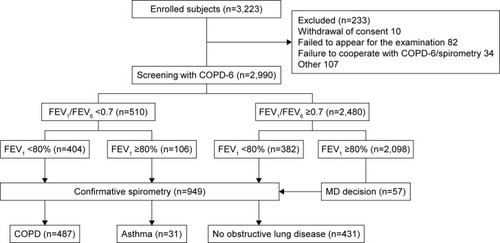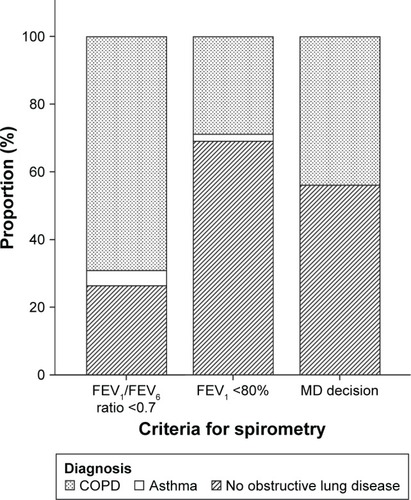Figures & data
Table 1 Baseline characteristics of all enrolled subjects (n=2,990) and classification according to whether participants were only screened with COPD-6 test (n=2,041) or proceeded to confirmative spirometry (n=949)Table Footnotea
Figure 1 CONSORT diagram of enrolled subjects.
Abbreviations: COPD, chronic obstructive pulmonary disease; FEV, forced expiratory volume; FVC, forced vital capacity; MD, medical doctor’s.

Table 2 Prevalence of airway obstruction (FEV1/FVC <0.70) at the COPD-6 test and at pre- and post-bronchodilator spirometry according to criteria for performing confirmative spirometry
Figure 2 Prevalence of final diagnosis, that is, COPD, asthma, or no obstructive lung disease, according to the three different criteria for proceeding to confirmative spirometry.
Notes: Criteria for, 1) COPD: post-bronchodilator (BD) FEV1/FVC <0.7 and ΔFEV1 <0.5 L at BD reversibility test; 2) asthma: ΔFEV1 ≥0.5 L at BD reversibility test; Non-OLD: not fulfilling criteria 1) or 2). MD decision: MD decision to perform confirmative spirometry based on suspicion of COPD and an FEV1/FVC ratio close to 0.7. Subjects with both FEV1/FEV6 ratio <0.7 and FEV1 <80% were counted in the group “FEV1/FEV6 ratio <0.7”.
Abbreviations: FEV, forced expiratory volume; FVC, forced vital capacity; MD, medical doctor’s; OLD, obstructive lung disease.

Figure 3 Comparison of the FEV1/FEV6 ratio for subjects with airway obstruction (defined as FEV1/FEV6 <0.70) at the COPD-6 test (A) (n=510) with the FEV1/FVC ratio at the subsequent post-BD spirometry (B).

Table 3 Characteristics of subjects diagnosed with COPD compared to subjects diagnosed with asthma and no obstructive lung disease (no OLD)Table Footnotea,Table Footnoteb
Table 4 Spirometry data grouped by selection criteria for confirmative spirometry
